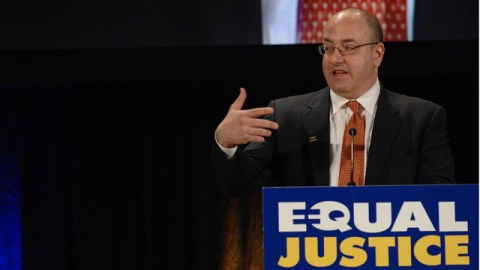Stanford Law’s Larry Kramer on the Law School Revolution

Globalization has transformed the practice and study of law, says Larry Kramer, the dean of Stanford Law School. American law firms have dominated the internationalization of law, but this has spelled major changed for the economic structure of these firms. The biggest law firms in 1980, he said, were 200 to 250 lawyers; now they grown so rapidly they might have upwards of 8,000 lawyers. “And firms that might have had 2 or 3 offices, suddenly have 20 or 30 offices all over the world.”
In his Big Think interview, Kramer said law schools must adapt themselves to this new world order. Historically, law schools were seen as just the first step in a legal education: “There was only … a tangential connection between legal education in school and the practice of law. Law schools taught essentially one skill, one core skill, for being a lawyer, which we refer to generically as … how to think like a lawyer.” All practical law knowledge they would learn from a law firm, which for the first three or four years was essentially like an apprenticeship. But now first and second year associates are expected to hit the ground running, billing hours right from the start, so there is less time to train associates from within the workforce.
Leading the charge, Kramer has revolutionized the way Stanford Law approaches the three-year law program. “One of the well-known facts about law school is it never took three years to do what we were doing; it took maybe two years at most, maybe a year-and-a-half,” he says. So at Stanford Law the first year is very traditional, focusing exclusively on training students how to think like lawyers, but the second and third years are radically different, the goal being to better prepare students to serve clients. So on the one hand, Stanford has entirely shifted the course load in these two years, which “changes the conceptual and analytical tool kit that students leave with, so they have not just the one tool, how to think like a lawyer, but they’ve got other ones as well.” Having armed students with this knowledge, Stanford then gives them “some sense of how to deploy it, in a real context.”
Kramer also talked about the disaster that is the current hiring process for large law firms, which works in nobody’s favor: “From the firm’s perspective, the big issue is they’re hiring people so far ahead they don’t know what their needs are going to be, and they also really don’t know what they’re buying…[And] from the student’s perspective, they’re making a choice about a career, when at the vast majority of law schools, they’ve only had required first year courses; they have no idea what’s going to be interesting to them in law because they haven’t had any opportunity to explore.” Kramer suggests that a more reasonable hiring process would begin at the end of the second year or later, after students have a chance to develop their interests and skills. But little is likely change: “competition just makes it impossible, and nobody wants to be the first mover.”
And all of this, Kramer says, has contributed to the perception that lawyers are the most depressed professionals. While he think these reports are “somewhat exaggerated,” he did suggest public service as a way to feel more fulfilled.





